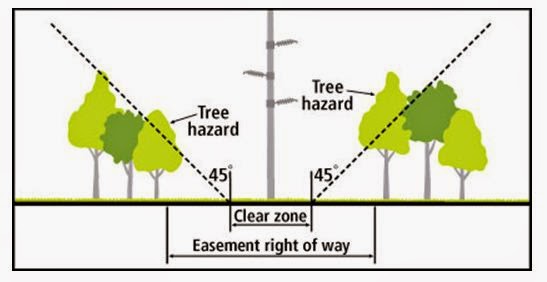The limitations period in North Carolina is six (6) years within which to bring a lawsuit claiming an encroachment on an easement, which is an injury to an "incorporeal hereditament". NCGS 1-50(a)(3).
In Duke Energy Carolinas, LLC v. Gray, No. COA14-283 (December 2, 2014), the N.C. Court of Appeals considered the utility's claim that defendant's home encroached on the utility's easement, and the defendants' statute of limitations defense to the utility's encroachment claim.
Facts
The facts are quite straightforward as presented by the appellate court. In May 1951, property owners executed an agreement with the utility granting a 200-foot easement over their property "for purposes associated with the transmission of electric and telephone services".
In 2006, a homebuilder built a house on a lot that "included a strip of land located within plaintiff's easement".
In 2007, homebuilder conveyed the lot and house to defendant by general warranty deed "subject to easements 'which may appear of record[.]'".
In February 2010, utility wrote to defendant "and informed him that a portion of [defendant's] house encroached on its 200-foot right of way". In December 2012, utility filed suit seeking a mandatory injunction "directing defendant to remove the encroachment from [utility's] easement", and defendant filed a third party complaint against homebuilder.
Trial Court
Defendant and homebuilder moved for summary judgment on its 6-year statute of limitations defense, which the trial court granted. Plaintiff appealed.
The Appeal
The North Carolina Court of Appeals affirmed the trial court's decision.
First, the Court reveals that the 6-year limitations period from NCGS 1-50(a)(3) is correctly applied to this easement.
Next, the Court concludes that the limitations period runs from the date the easement is "injured", "even when the injured party is unaware that the injury exists". In other words, the Court determines that a cause of action for encroachment on an easement accrues upon the injury regardless when it is discovered or reasonably should be discovered. The Court makes it clear that the the "apparent or ought reasonably to have become apparent" language of NCGS 1-15(c) does not exist in or otherwise apply to the 6-year limitations period for "incorporeal hereditaments" at NCGS 1-50(a)(3). The Court: "[T]here is no such provision in N.C. Gen. Stat. § 1-50(a)(3), and no other statutory basis to delay the accrual of a claim for encroachment on an easement until the encroachment is discovered, or reasonably should be known."
The Court makes an interesting analysis of plaintiff's claims that summary judgment on the limitations defense "terminated" or "extinguished" the easement and allowed defendant to "obtain property without satisfying the required elements for adverse possession". The Court's response to these arguments must be quoted:
Plaintiff’s easement was not terminated or extinguished as a result of the summary judgment order. Plaintiff retains its easement, and may pursue any future claims arising from an encroachment to the easement, whether caused by this defendant or another party. Furthermore, in appropriate circumstances, plaintiff may exercise its power of eminent domain under N.C. Gen. Stat. § 40A-3(a)(1). In addition, defendant did not obtain title to any property he had not previously owned; indeed plaintiff concedes that defendant is “the owner of the underlying property[.]” Thus, the only effect of plaintiff’s failure to file suit before expiration of the statute of limitations was to bar its lawsuit against defendant based upon this specific encroachment.
Essentially, the easement remains -- defendant's home is not "in the clear" -- but the encroachment claim is the one that's barred. Other avenues remain to remove the structure from the utility's easement, according to the Court.
Finally, the Court addresses the arguments that (1) the original grant of easement was "under seal", which carries a 10-year limitations period (the Court: defendant was not a "principal" to the original grant of easement, so the "uynder seal" argument is inapplicable) and (2) prior precedent on which the Court relies is incorrectly decided (the Court: "a subsequent panel of the same court is bound by that precedent") and (3) for policy reasons, a six-year window from injury to an easement regardless when it is discovered or reasonably should be discovered will overwhelm utility companies (the Court: these are legislative issues, not judicial ones).
While a unanimous decision affords no review "as of right" by the State Supreme Court, we anticipate another look by the highest court and/or the legislative change alluded to by the Court of Appeals.




 i
i

